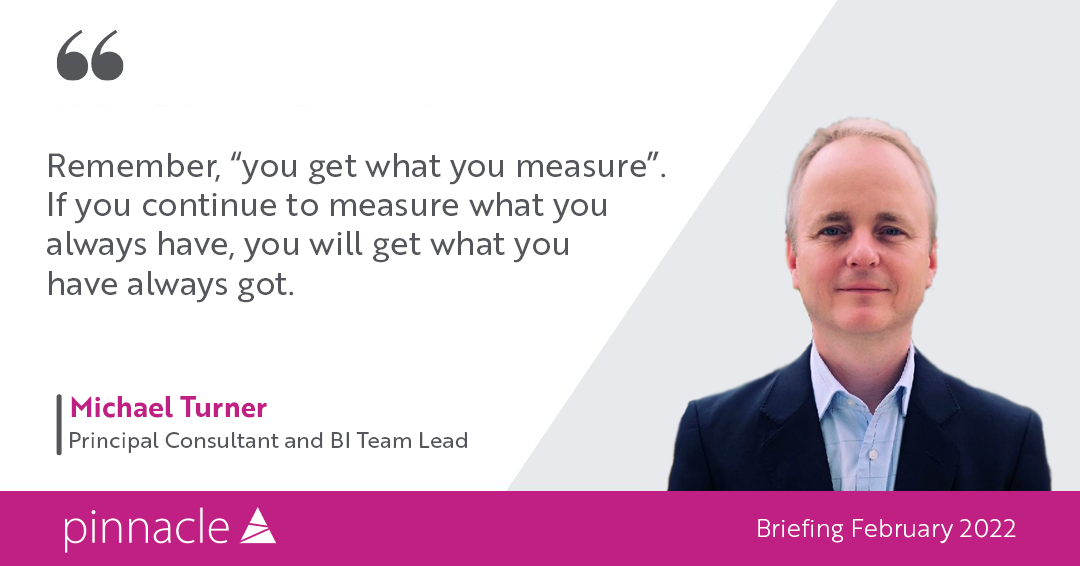
Firms need to change their business intelligence approach to keep up with new and more sophisticated expectations, says Michael Turner, principal consultant & BI team lead at Pinnacle, who offers a plan of action for legal businesses to develop an “everything, everywhere” scheme for business reporting.
The last ten years have seen a step change in the way information can be organised and presented, and law firms are embracing new possibilities at a pace never seen before. Pinnacle has been responsible for delivering over forty Business Intelligence (BI) projects in the last year alone and we see no sign of the desire to be innovative, or the rate of adoption, letting up. Taking action now and at pace is critical – but, if they want to be successful, firms must not rush past the strategic planning step of determining the value they want to deliver and the stages of how to get there.
Intelligence expectations
There are several factors which have influenced firms’ increased appetite for change and the acceleration of efforts, as well as greater expectations, around BI.
The rise of boutique legal reporting solutions and a demonstration of possibilities has meant that law firms have started to demand more from legal practice management system suppliers and their own internal service teams. Practice Management Solution (PMS) providers have enhanced their offerings to meet this demand as they realised that a strong reporting solution was a basic client expectation and helped to sell their software.
Microsoft invested in Power BI, a strategy which has paid off in its own right and also led to the development of solutions to complement the product. This has rounded their vision both functionally and commercially. Microsoft’s new strategy has made it easier for IT and business teams to deliver on stakeholders’ expectations, resulting in enhanced user experience and powerful, performant solutions that became cheaper and easier to own and maintain.
Lastly, users have become tech-savvy through applications they used in a personal capacity. Intuitive real-time dashboards in banking and other apps have given senior stakeholders reference points for data consumption and user experience. It didn’t take long before they started looking for a similar experience based on applications they used in their personal lives.
Consistently reporting everything
Most firms now have their data in good shape in certain areas – financial data is easier to organise than other areas, for example – but not across the board. This lack of consistency is inefficient and usually accompanied by problems that are masked from the business by cumbersome manual intervention. These practices are possible to maintain when information is only reported periodically, but stakeholders are starting to question current levels of capability and how it can be further enhanced. They recognise that siloed data needs to be joined up.
The most successful law firms will develop solutions with an ‘everything everywhere’ assumption in mind. In practice, this means that the reporting framework should be flexible enough to provide information from any system at the right time, whenever it will add business value and support the decision-making process.
Approaching process perfection
Getting to a place of “everything everywhere” is a challenge that most firms will struggle with but, in our experience, really focusing on three key areas will allow you to be in a strong position. These are:
Data quality
Good-quality data means cleaning your data and, crucially, keeping it clean. If we’re basing decisions on information we make available from our systems, it’s vital that the information is correct. Helping users to input data correctly and consistently by using external data feeds is one way but data quality monitoring and cleansing can be automated with the right tools and ongoing management.
Scalability, security and scope
Establish a scalable and robust approach to data organisation, security and availability. Building siloed datasets using proprietary methods will hamper progress and, while transactional systems are the point of capture for the information, improving reporting in isolation is more tactical than strategic. It’s like insulating a room of your house rather than the roof.
Think bigger than your individual transactional applications. Consider tools that are able to span the network and draw together information from multiple systems to help users make better decisions. Applications in the Microsoft stack have unlocked possibilities here and forward-thinking law firms are adopting these solutions to speed up process flow and improve decision-making. It goes without saying that data security is a key consideration here.
Change and business engagement
Engage the business to drive change together. Many firms rehash iterations of the same reporting outputs across so-called ‘transformation’ projects. Fee-earning teams are wedded to these outputs as they worry that an alternative would cause them issues and lead to greater inefficiency and more work for them. Remember, “you get what you measure”. If you continue to measure what you always have, you will get what you have always got. Working with the latest systems without embracing new functionality and ways of working caps return on investment. Don’t be afraid to engage the business from an early stage, build allies across the business from the outset and work with them so that they understand the possibilities and are open to greater efficiency and capability.
________________________________________________________
This article first appeared in Briefing February 2022.
